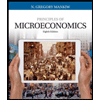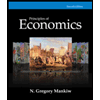
The income inequality in the US.
Explanation of Solution
Table -1 shows the distribution of US income by households in 2008:
Table -1
| Personal Income Category | Percentage of all households in this category |
| Under $10,000 | 7.1 |
| $10,000-$14,999 | 5.8 |
| $15,000-$24,999 | 11.8 |
| $25,000-$34,999 | 10.9 |
| $35,000-$49,999 | 14.0 |
| $50,000-$99,999 | 17.9 |
| $100,000 and above | 11.9 |
| 20.5 | |
| 100.0 |
As per table -1, the highest 20% have received an income share of 50% in 2008. This is ten times more than the 3.4% than the lowest 20% received. The three quintiles in the middle get less that 50% of the total income before tax. When we combine the bottom three quintiles on top of two quintiles that receive almost twice of them. So, the fact is that the top to 20% are receiving as much as 80% at the bottom.
The government's effect on the income distribution happens through taxes and transfer payments. It has a slightly progressive effect of federal, state, and local taxes on distribution of income as people with a high income have a pay of a higher percentage of their income in taxes when compared to people with a lower income. The main contribution of the government for income equality happens through transfer programs i.e. 80% of the times. The benefit of this contribution goes mainly to people in the lowest quintile where 75% of the income that these people earn is through government transfer payments.
Though these statistics may suggest that the government is contributing heavily to equalize the income, it might be all correct. As the transfer programs provided to people with a lower income decrease the incentive to work so the income earned will be further down. Also, not all these transfer programs got to the poor. For example, in case of subsidies, farming always goes to the farmers that are wealthy. Middle and higher class students get the benefit of education funding by the government than the ones with a lower income.
Concept Introduction:
Income inequality: It is the unequal distribution of a household or an individual income across the various participants in an economy.
Want to see more full solutions like this?
Chapter 21 Solutions
Micro Economics / Macro Economics Spokane Falls Commnity College SFCC Econ 201/202
- B G C D E H M K Armchair For puzzles 96 and 97, use the first phylogenetic tree on the following page (Figure 2). 96) Who is the most recent common ancestor of species A and species G? 97) Who is the most recent common ancestor of species D, E, and F?arrow_forwardNot use ai pleasearrow_forwardNot use ai pleasearrow_forward
- Stealth bank has deposits of $700 million. It holds reserves of $20 million and has purchased government bonds worth $350 million. The banks loans, if sold at current market value, would be worth $600 million. What is the total value of Stealth bank's assets? I believe my calculation of 1.3 billion may be incorrect May I have my work checked pleasearrow_forwardThe following graph shows the downward-sloping demand curve for Oiram-46, a monopolist producing unique magic hats. The graph also shows Oiram-46's marginal revenue curve and its average total cost curve. On the following graph, use the orange point (square symbol) to indicate the profit-maximizing quantity. Use the blue point (circle symbol) to indicate the profit-maximizing price. Use the purple point (diamond symbol) to indicate the average total cost. Use the tan rectangle (dash symbol) to show Oiram-46's total revenue and the grey rectangle (star symbol) to show its total cost. PRICE (Dollars per magic hat) 2 0 20 Marginal Cost 18 ATC 16 Profit-Maximizing Quantity 14 12 Profit-Maximizing Price MC 8 Demand 02 4 6 8 10 12 14 16 18 20 QUANTITY (Magic hats per week) Based on the graph, Oiram-46's profit is equal to 5 TOTAL SCORE: 1/4 Average Total Cost Total Revenue Total Cost Grade Step 2 (to complete this step and unlock the next step)arrow_forwardExplain information regarding the effective interest rates being charged and how much higher the rent-to-own stores’ cash price exceeded the price of the identical item at a reputable retail outlet.arrow_forward
- How can Rent-to-own industries avoid the restrictions on interest rates? Explain.arrow_forwardExplain why rent-to-own operations are so attractive to so many people compared to saving the money to buy the desired item or going to a thrift store to acquire the item?arrow_forwardExplain the business practices of the rent-to-own industry.arrow_forward
 Principles of Economics 2eEconomicsISBN:9781947172364Author:Steven A. Greenlaw; David ShapiroPublisher:OpenStax
Principles of Economics 2eEconomicsISBN:9781947172364Author:Steven A. Greenlaw; David ShapiroPublisher:OpenStax Principles of MicroeconomicsEconomicsISBN:9781305156050Author:N. Gregory MankiwPublisher:Cengage Learning
Principles of MicroeconomicsEconomicsISBN:9781305156050Author:N. Gregory MankiwPublisher:Cengage Learning Principles of Economics (MindTap Course List)EconomicsISBN:9781305585126Author:N. Gregory MankiwPublisher:Cengage Learning
Principles of Economics (MindTap Course List)EconomicsISBN:9781305585126Author:N. Gregory MankiwPublisher:Cengage Learning Principles of Microeconomics (MindTap Course List)EconomicsISBN:9781305971493Author:N. Gregory MankiwPublisher:Cengage Learning
Principles of Microeconomics (MindTap Course List)EconomicsISBN:9781305971493Author:N. Gregory MankiwPublisher:Cengage Learning Principles of Economics, 7th Edition (MindTap Cou...EconomicsISBN:9781285165875Author:N. Gregory MankiwPublisher:Cengage Learning
Principles of Economics, 7th Edition (MindTap Cou...EconomicsISBN:9781285165875Author:N. Gregory MankiwPublisher:Cengage Learning





